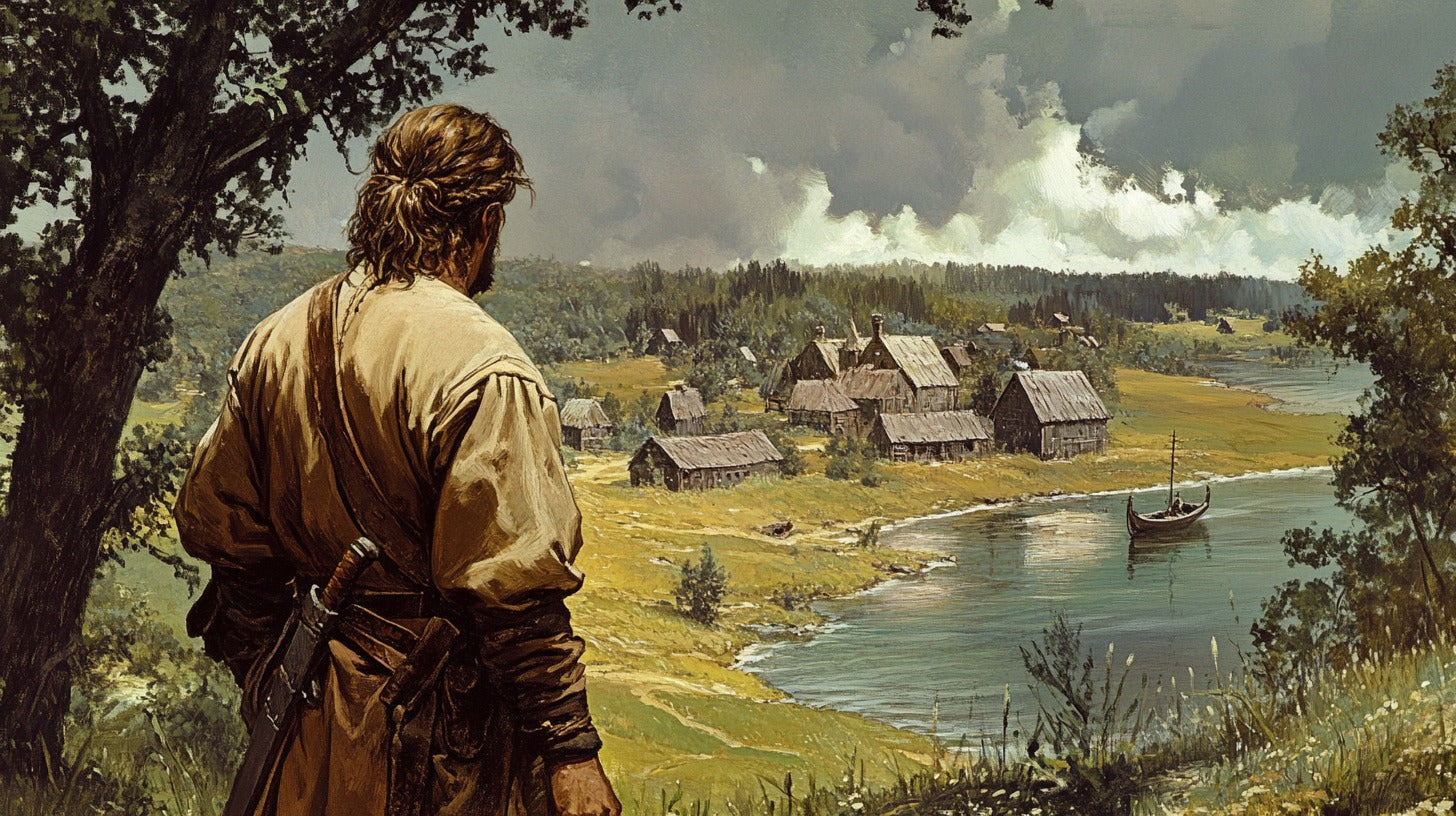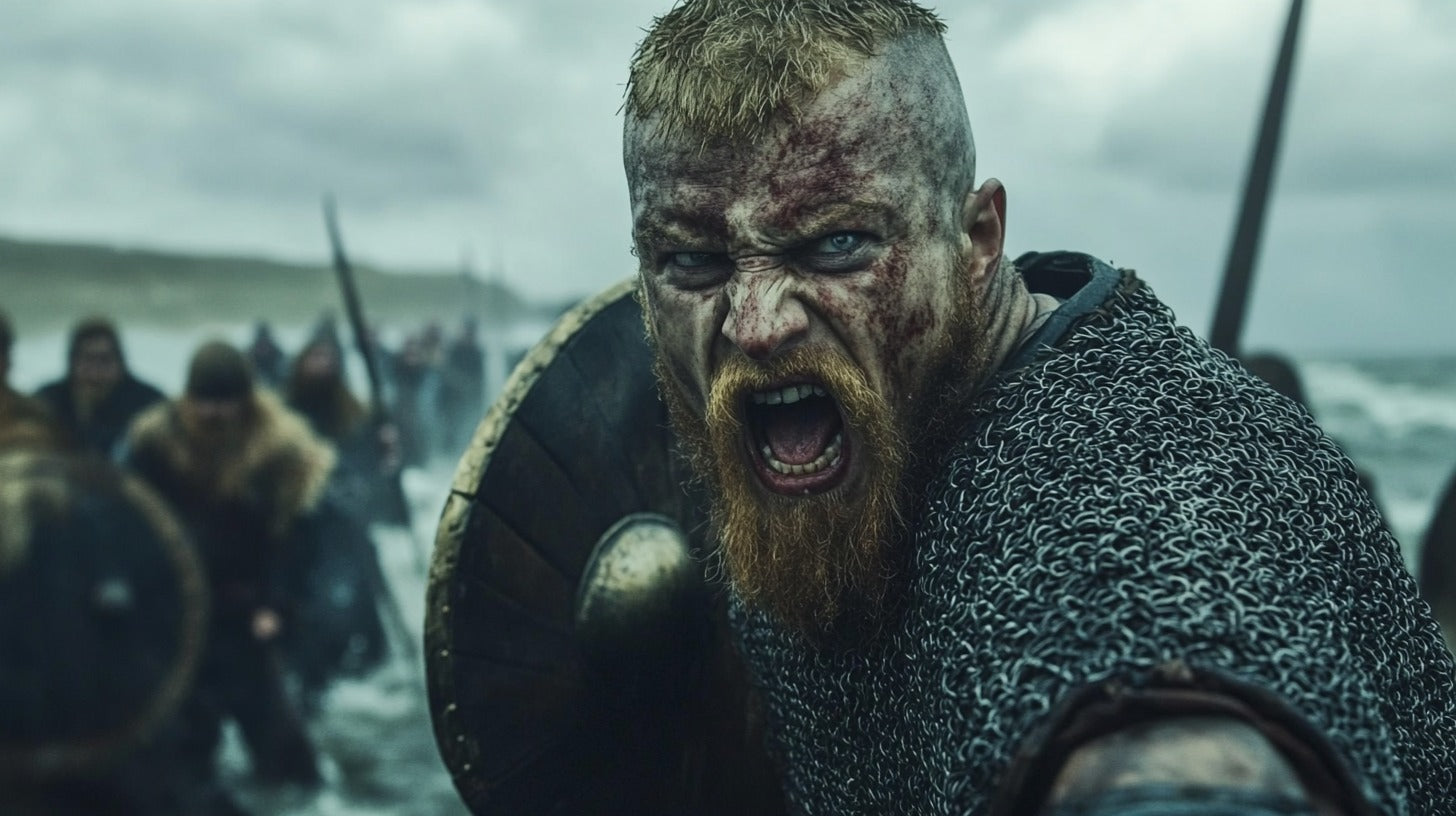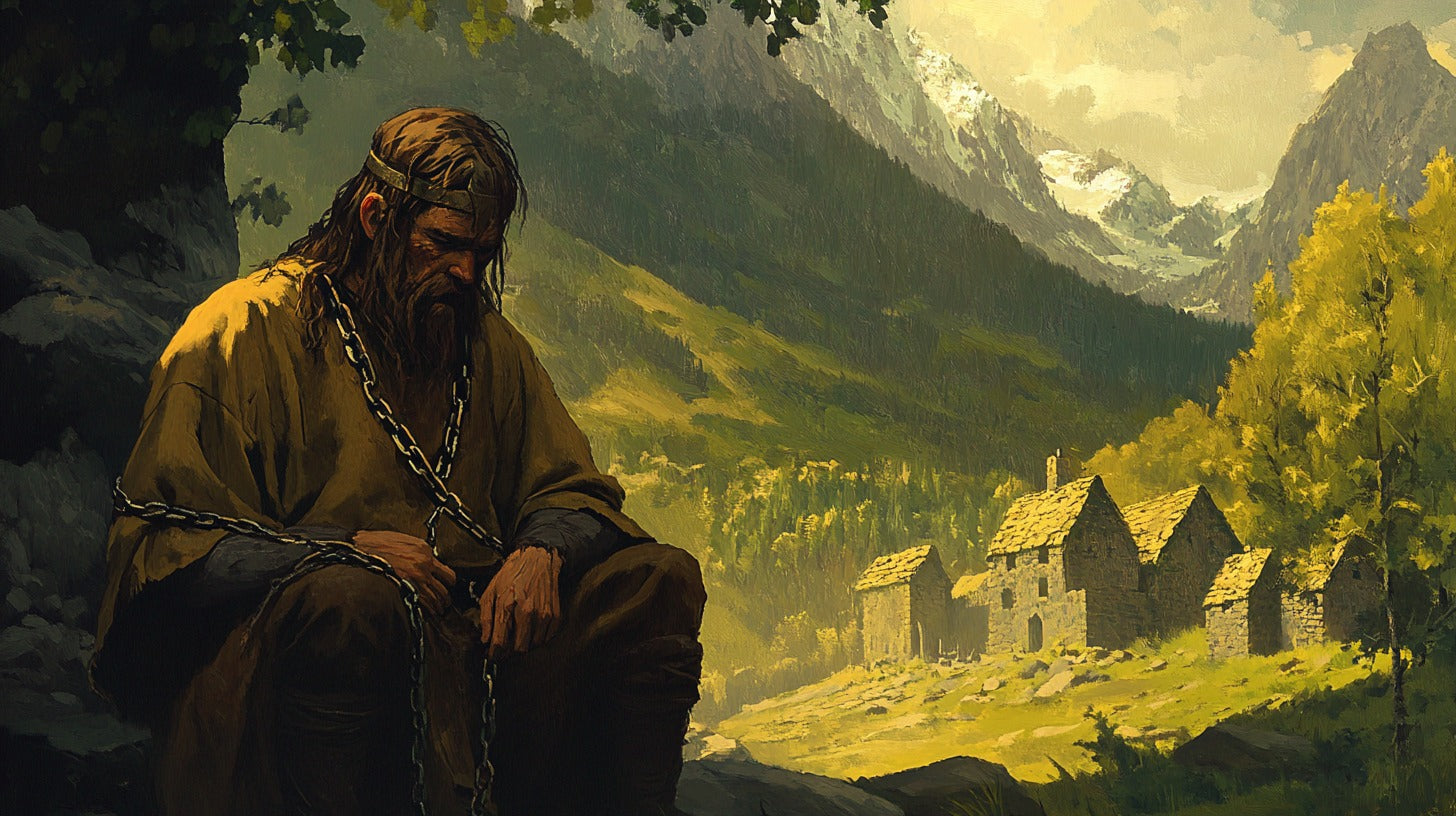
Leif the Lucky: How a Viking Discovered a New World
Long before the Niña, the Pinta, and the Santa María set sail from Spain, a Viking longship cut through the icy waters of the North Atlantic, carrying a crew of hardy Norsemen led by Leif Eriksson. Their journey would take them to a land of plenty, a New World that would remain a secret for nearly five hundred years.
Early Life and Family Background
Erikson commemorative stamp, issued October 9, 1968, Leif Erikson Day
Growing Up in Iceland
Leif Eriksson's tale begins not in the lush forests of Vinland, but in the rugged, volcanic landscape of Iceland. Born around 970 CE, Leif was a child of two worlds - the old pagan traditions of his Viking ancestors and the new Christian faith that was slowly making its way across the Norse lands.
Iceland, with its geysers and glaciers, was a land that forged strong men and women. It was here that Leif learned the ways of the sea, the art of navigation, and the sagas of his people. The harsh beauty of his homeland would shape him into the explorer he was destined to become.
The Influence of Erik the Red
But it was Leif's father, Erik the Red, who would cast the longest shadow over his life. Erik, a man as fiery as his hair and beard, was a force of nature unto himself. Exiled from Iceland for manslaughter, Erik would go on to discover and settle Greenland, setting the stage for his son's even greater discovery.
From his father, Leif inherited not just his red hair, but also his restless spirit and his iron will. Erik's tales of new lands and new opportunities would plant the seeds of wanderlust in young Leif's heart, seeds that would one day bloom into a journey that would change the course of history.
The Journey to Greenland

Leif's Talisman - Valknut Vegvísir Ring
Establishing the Norse Settlements
When Leif was still a young man, he joined his father in the great venture to settle Greenland. It was a perilous journey across the storm-tossed North Atlantic, a voyage that would have tested the mettle of even the most seasoned Viking.
Imagine, if you will, the sight that greeted young Leif as the longships approached the coast of Greenland. Towering icebergs, gleaming like crystal fortresses in the pale Arctic sun. Jagged coastlines of black rock, softened here and there by patches of green that gave the land its misleading name. It was a realm of harsh beauty, a place where only the strong could hope to survive.
Life in the New Colony
Life in Greenland was not easy. The Norse settlers had to contend with long, dark winters, poor soil, and the ever-present threat of starvation. But they were a hardy people, and under the leadership of Erik the Red, they persevered.
It was in this unforgiving environment that Leif truly came into his own. He learned to hunt seals on the ice floes, to navigate by the stars in the crystal-clear Arctic nights, and to read the moods of the sea and sky. Little did he know that these skills would one day lead him to a discovery that would eclipse even his father's achievements.
Conversion to Christianity

Coin of Olaf Tryggvasson (Olaf I of Norway).
The Mission from King Olaf I
The Saga of Erik the Red tells of an unexpected turn in Leif's life when he travelled to Norway around the year 999 CE. In this version of events, Leif entered the service of King Olaf I Tryggvason, who had recently converted to Christianity and was eager to spread the new faith to the Norse colonies.
According to this saga, the king saw in Leif a man of extraordinary qualities - brave, intelligent, and charismatic. Who better to carry the message of Christ to the pagan settlements of Greenland? And so, as this tale goes, Leif was baptized and commissioned as a missionary, a role that would add yet another layer to his already complex character.
It's important to note that the Saga of the Greenlanders presents a different account of Leif's conversion and his reasons for traveling west. This version of Leif's story, with its focus on his missionary role, is unique to the Saga of Erik the Red.
Spreading the Faith in Greenland
Returning to Greenland, Leif faced perhaps his greatest challenge yet. How could he, the son of Erik the Red, convince his people to abandon the gods of their ancestors? It was a task that required all of his diplomacy, all of his charisma, and perhaps a touch of the divine.
Yet, against all odds, Leif succeeded. He introduced Christianity to Greenland, building the first church on the island. It was a turning point not just in Leif's life, but in the history of the Norse people. The old ways were changing, and Leif Eriksson was at the forefront of that change.
The Voyage to Vinland

Leiv Eirikson Discovering America by Christian Krohg (1893)
Inspiration and Preparation
But it was not faith alone that drove Leif Eriksson. The call of the unknown, the lure of undiscovered lands, still sang in his blood. Two sagas tell different tales of how Leif came to seek these western shores.
The Saga of the Greenlanders speaks of a merchant named Bjarni Herjólfsson, blown off course years before, who glimpsed mysterious lands but never set foot upon them. In this telling, Bjarni's tales ignited Leif's imagination. What lands lay beyond the western horizon? What riches, what adventures might be found there?
The Saga of Erik the Red, however, paints a different picture. It claims Leif himself was the first to spot the new lands, driven off course during a voyage to Greenland. In both versions, the spirit of his father's explorations burned in Leif's heart. With the blessing of King Olaf still fresh, Leif began to prepare for the greatest journey of his life, whether inspired by Bjarni's tales or his own chance discovery.
The Voyage Begins
And so, around the year 1000 CE, Leif Eriksson set sail into the unknown. But fate, it seemed, had its own plans. Whether following Bjarni's route or charting his own course, Leif's ship ventured into waters no Norse vessel had ever deliberately sailed, south of Greenland and towards a new world.
Helluland: The Land of Flat Stones
The first land Leif and his crew sighted was a barren place of flat stones and glaciers. They named it Helluland, "the land of flat stones," and it was likely what we now know as Baffin Island. But this desolate shore was not what Leif sought, and so they sailed on.
Markland: The Land of Forests
Next, they came upon a forested land, rich with timber - a resource prized by the Norse. They called this place Markland, "the land of forests," possibly modern-day Labrador. But still, Leif pressed on, driven by some instinct that greater discoveries lay ahead.
Vinland: The Land of Wine
Finally, after sailing for two more days, Leif and his crew landed in a place they would name Vinland, "the land of wine." Here, they found wild grapes growing in abundance, a climate mild enough to allow cattle to graze outdoors all winter, and rivers teeming with salmon larger than any they had ever seen.
Leif Eriksson had discovered North America, nearly 500 years before Christopher Columbus would make his famous voyage.
Life in Vinland

Establishing a Settlement
Leif and his crew wintered in Vinland, building simple houses and exploring the surrounding area. They marveled at the abundance of the land - the forests full of game, the rivers and coastal waters rich with fish, the wild berries and grapes that grew in profusion.
For men accustomed to the harsh realities of life in Greenland and Iceland, Vinland must have seemed like paradise. One can only imagine the sense of wonder and excitement that filled their hearts as they explored this new world.
Encounters with Native Americans
But Leif and his men were not alone in this new land. They encountered indigenous people, whom they called Skraelings. These encounters were sometimes peaceful, sometimes hostile, but always fraught with the tension of two vastly different cultures coming into contact for the first time.
These meetings were the first documented encounters between Europeans and Native Americans, a moment of profound historical significance that would set the stage for centuries of interaction, both good and ill.
Return to Greenland

The Impact of the Discovery
After spending a winter in Vinland, Leif and his crew returned to Greenland. They brought with them samples of the new land's bounty - timber, grapes, and tales of a land of plenty that must have seemed almost mythical to those who heard them.
Leif's discovery electrified the Norse community in Greenland. Here was a new land, rich in resources, ripe for settlement. It sparked a series of expeditions that would continue for several years, including voyages by Leif's own siblings.
Leif's Later Life
Despite the excitement surrounding Vinland, Leif himself never returned. He remained in Greenland, taking over leadership of the Norse colony after his father's death. He continued to promote Christianity and ruled wisely, earning the nickname "Leif the Lucky."
But one has to wonder - did Leif ever gaze out across the western sea, remembering the lush forests and abundant grape vines of Vinland? Did he ever regret not returning to the land he had discovered?
Legacy and Historical Significance

Statue of Leif Erikson by Sculpor Daniels, John K, located in Leif Erikson Park, Duluth, Minnesota / Photo: Sharon Mollerus, CC BY 2.0.
The Vinland Sagas
Leif's voyages and discoveries were recorded in the Vinland Sagas, a series of Norse tales written down centuries after the events they describe. These sagas, while embellished with legendary elements, preserved the core of Leif's story and kept alive the memory of Vinland.
For centuries, these tales were dismissed as mere legend by most historians. It seemed incredible that Norse explorers could have reached North America centuries before Columbus. But Leif Eriksson and his men had indeed accomplished this remarkable feat.
Archaeological Evidence
It wasn't until 1960 that archaeological evidence confirmed the truth of the Vinland Sagas. The discovery of a Norse settlement at L'Anse aux Meadows in Newfoundland proved beyond doubt that the Vikings had indeed reached North America around the year 1000 CE.
This discovery revolutionized our understanding of pre-Columbian contact between the Old and New Worlds. Leif Eriksson, once dismissed as a figure of legend, was suddenly catapulted into the ranks of history's greatest explorers.
Leif Eriksson in Modern Culture

Leif Eriksson, as portrayed by Sam Corlett in the Neflix show 'Vikings: Valhalla'
Commemorations and Monuments
Today, Leif Eriksson is celebrated as a hero of exploration. Statues of him stand in cities across North America and Europe. In the United States, October 9th is observed as Leif Eriksson Day, a testament to the enduring fascination with this Norse explorer.
Influence on Literature and Media
Leif's story has inspired countless books, films, and television shows. His voyage to Vinland has captured the imagination of artists and storytellers, who continue to find new ways to interpret and present his remarkable journey.
From serious historical novels to fanciful retellings, Leif Eriksson's discovery of America continues to resonate with audiences today, a reminder of the spirit of exploration that drives humanity to seek out new horizons.
Conclusion
Leif Eriksson's journey to Vinland was more than just a voyage of discovery. It was a moment that connected two worlds, bridging the gap between the Old World and the New nearly five centuries before Columbus. His story is a testament to the courage, skill, and adventurous spirit of the Norse people.
As we look back on Leif's achievements, we're reminded of the power of human curiosity and the drive to explore the unknown. In our modern world, where it can sometimes feel like there are no new frontiers to discover, Leif's story continues to inspire us to look beyond the horizon, to seek out new challenges, and to embrace the spirit of adventure that led a Viking ship to the shores of a new world a thousand years ago.
FAQs
- When did Leif Eriksson discover America?
Leif Eriksson is believed to have reached North America around the year 1000 CE.
- Where exactly did Leif Eriksson land in North America?
While the exact location is debated, it's believed he landed somewhere along the coast of what is now Newfoundland or Labrador.
- Did Leif Eriksson establish a permanent settlement in North America?
Leif himself didn't establish a permanent settlement, but later Norse expeditions did attempt to settle in Vinland.
- How long did Leif Eriksson stay in Vinland?
According to the sagas, Leif and his crew spent one winter in Vinland before returning to Greenland.
- Why isn't Leif Eriksson more widely recognized as the discoverer of America?
The Norse discovery of America remained largely unknown outside Scandinavia for centuries, and by the time it became widely accepted, Columbus was already firmly established in popular history as the discoverer of America.
References
Kolodny, A. (2012). In Search of First Contact: The Vikings of Vinland, the Peoples of the Dawnland, and the Anglo-American Anxiety of Discovery. Durham: Duke University Press.
Seaver, K.A. (2010). The Last Vikings: The Epic Story of the Great Norse Voyagers. London: I.B. Tauris.
Fitzhugh, W.W., & Ward, E.I. (2000). Vikings: The North Atlantic Saga. Washington: Smithsonian Institution Press.
Magnusson, M., & Pálsson, H. (1965). The Vinland Sagas: The Norse Discovery of America. London: Penguin Books.
Wallace, B.L. (2003). L'Anse aux Meadows, Leif Eriksson's Home in Vinland. Journal of the North Atlantic, 2, 114-125.







